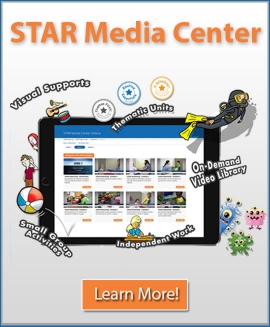Preparing Kids for Success in General Education Settings
What’s so special about special education? Well, aside from spending time with some of the coolest kids in town, educators in the field make it their duty to prepare their students to be as successful as possible with their typical peers in diverse settings. Ultimately, our goal is to work ourselves out of work!
Take a moment and think about the first student who comes to mind in your classroom and identify the biggest barrier(s) to his or her success in the general education environment. I’m guessing you might say behavior? Sure, some of you may be thinking that he or she can do the work, and may even be able to demonstrate some good social skills, but they can’t seem to do anything without a million verbal cues or redirections. Or, maybe you’re thinking of the student who can’t make it from the small group table to the carpet without orbiting the classroom with the speed and intensity of a category five hurricane. Either way, we’re talking about behavior, everyone’s favorite subject.
We know that we can teach appropriate social and classroom behaviors through discrete trial (DT) instruction. Our students become masters at walking in the hallways, responding to attending cues, and imitating actions, but unless we plan to generalize those skills to other people and settings, we’ll continue to see students thrive in one environment and struggle mightily in another. Teaching through functional routines is an effective way to give students opportunities to practice skills learned in DT in contexts that are purposeful and meaningful to them, such as snack time or music specials. When teaching through routines, remember that we want to tell the student what to do. It’s really tempting to hurl all the variations on “no, thank you” at students while you’re collecting your routine data, but it’s much more effective to be clear in what you need them to be doing. An excellent visual cue for teachers and paraeducators is the penny board, because it is a reminder to reward students for performing the desired behaviors. Remember, if we want a behavior to occur again, we have to practice it with purpose and reinforce it!
The STAR Functional Routine lessons progress from learning to learn and participate in a school environment (e.g., transitioning between activities, hand washing) to full inclusion in general education (e.g., academic group instruction, restroom use with classmates). If the routine lessons in Levels I-III don’t fit the needs of your students, remember the blank routine data form is available in the Blackline Masters or on DVD for Version 2 users. When creating customized routines, it’s helpful to first identify the steps/behaviors you want the student to complete. Focus on what to do, and then finish by determining the environmental set-up and appropriate cue. Remember to use your routine data to determine any skills that need to be pre-taught through DT, PRT, or other instructional method. Our “orbiter” for example, may need to practice “walk with me,” attending skills, and following directions through DT in addition to instruction through routines. Happy orbiting!
Click the image below to download a Behavioral Support

